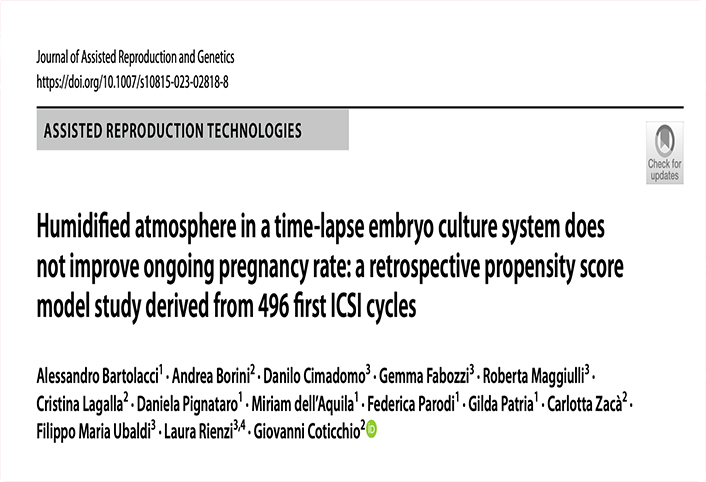
Alessandro Bartolacci, Andrea Borini, Danilo Cimadomo, Gemma Fabozzi, Roberta Maggiulli, Cristina Lagalla, Daniela Pignataro, Miriam dell’Aquila, Federica Parodi, Gilda Patria, Carlotta Zacà, Filippo Maria Ubaldi, Laura Rienzi, Giovanni Coticchio.
Journal of Assisted Reproduction and Genetics https://doi.org/10.1007/s10815-023-02818-8, Received: 30 December 2022 / Accepted: 25 April 2023, Published 3 May 2023
Abstract
Purpose To investigate whether high relative humidity conditions (HC), when using a time-lapse system (TLS) with sequential culture media, are beneficial to embryo culture, improving ongoing pregnancy rates.
Methods We included patients undergoing their first ICSI cycle treatment from April 2021 to May 2022. Patients assigned to dry conditions (DC) or HC were 278 and 218, respectively. We used a GERI TLS, three chambers configured in humidity conditions and three in dry conditions. The effect of HC on ongoing pregnancy rate was assessed by the propensity matched sample, to reduce potential differences between women undergoing either HC or DC and reduce biased estimation of treatment effect.
Result After adjusting for several confounding variables and applying the propensity score (PS), no significant differences were observed in the rates of normal (2PN) and abnormal (1PN and 3PN) fertilization, blastulation, top-quality blastocysts, frozen blastocysts, ongoing pregnancies, and miscarriages. The 2-cell (t2) and 4-cell (t4) stages and cell divisions between such stages occurred earlier and were more synchronous in the in DC.
Conclusion These results suggest that HC conditions do not improve the rate of ongoing pregnancy and several embryological outcomes, under the conditions used in this study based on a time-lapse system and sequential culture with day 3 medium change-over.
